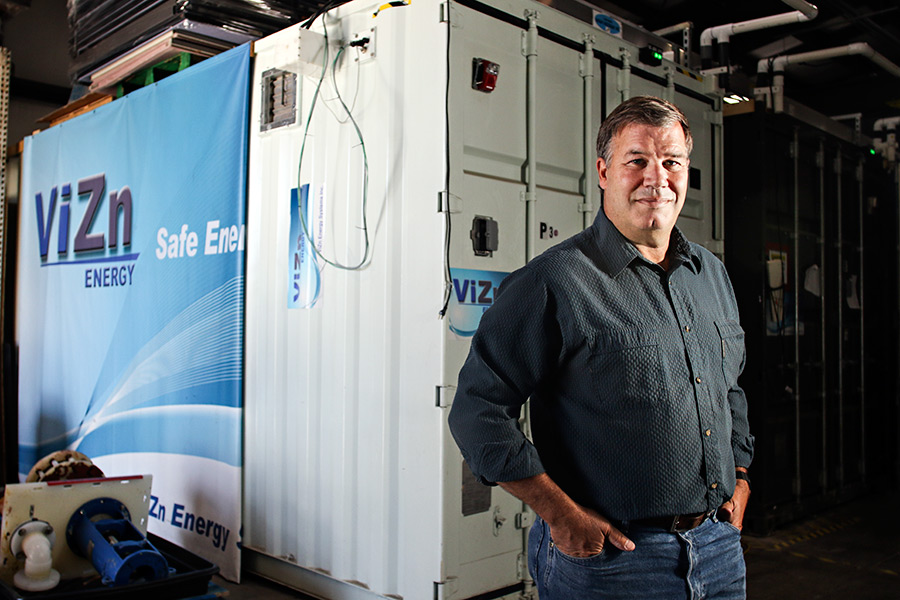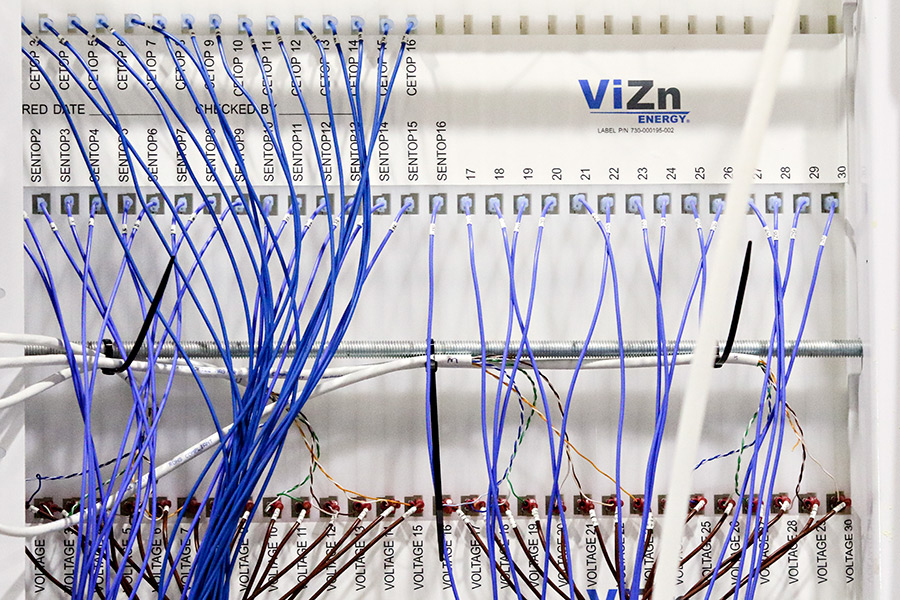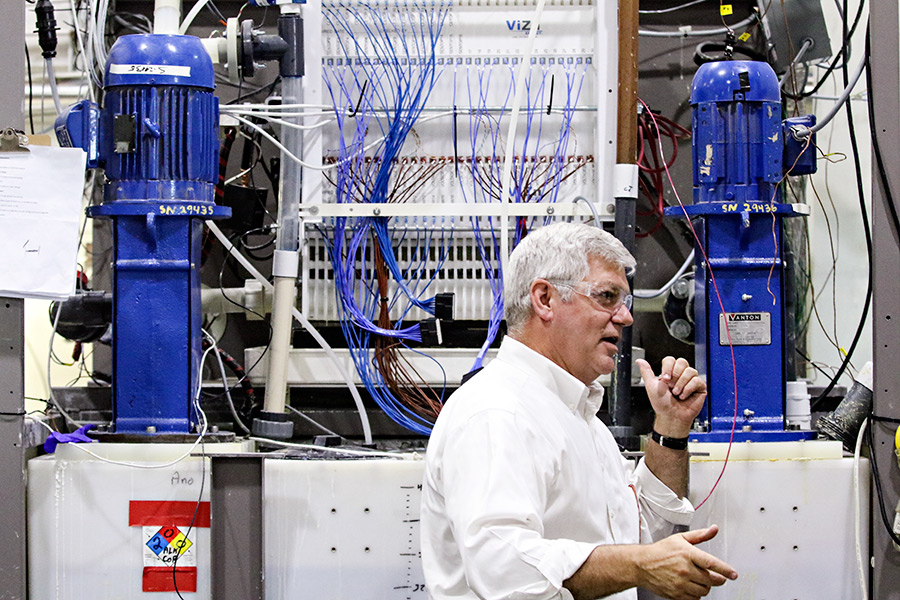Vision for the Future
As companies race to develop battery technology that could transform the global energy market, a startup in Columbia Falls thinks it has the answer
By Dillon Tabish
Last month, the German government reached a point of frustration in its audacious pursuit of becoming a global leader in clean energy. After two years of investing billions of dollars to reduce the use of fossil fuels and install large-scale solar parks and wind farms, the legislature sharply cut back subsidies and other financial incentives supporting renewable energy.
It wasn’t that the noble experiment had failed. In fact, the surge of solar and wind power was actually too great for the country’s traditional energy grid. Germany’s wind and solar systems have provided an abundance of power but at unpredictable times and intervals, making the grid unstable and vulnerable to damages and blackouts.
The solution is simple yet elusive. For all the recent technological advancements in renewables, including more affordable and efficient solar panels and wind turbines, one specific piece remains missing in the puzzle: when the sun sets or the wind stops blowing, the production of power completely halts. And even when these energy sources are present, there is no control mechanism, like throttling up or down the output of coal and gas plants.
There needs to be something big and stable enough to harness these massive amounts of renewable energy on a large scale – something that could smooth out energy generation on the grid and deploy power between peak and off-peak hours. Something such as a battery.
Germany’s electricity sector, while holding back green energy production for the time being, has now turned its attention to finding a solution that could aid in its mission to unplug from pollution-causing fossil fuels.
And the biggest economy in Europe thinks it might have found the answer. Of all places, it’s being developed inside a facility on the outskirts of Columbia Falls.

ViZn Energy Systems operates inside an unassuming building off U.S. Highway 2. Part of the facility is office space and the other larger portion is a warehouse laboratory where a team of more than 60 scientists, engineers, software technicians and others is working feverishly to refine what could be the missing piece in the clean energy revolution.
After six years of research and development, a state-of-the-art creation lies inside a 40-foot shipping container that sits inconspicuously outside the facility: the GS200, or Grid Scale 200 kilowatt energy storage system, which ViZn recently unveiled. It’s a zinc-iron redox flow battery, meaning it is a rechargeable fuel cell that uses electrolytes to convert chemical energy into electricity.
With an intricate computer control panel that acts as the brains of the battery, the system runs a series of pumps attached to tanks filled with electrolytes underneath stacks of battery cells. These batteries attach to a combination of the grid, solar panels or wind turbines and collect energy to store for future power. At max volume, each GS200 can independently power roughly 100 homes for three hours, according to ViZn officials. A good lithium-ion battery, the most common rechargeable battery on the market, can store four to five amp-hours in each cell. ViZn’s GS200 can store as much as 1,500 amp-hours in each cell.
“It’s a game-changer for the energy industry,” said Paul Siblerud, vice president of product marketing with ViZn and a third-generation Montanan who grew up in Creston.
With the advent of the GS200, the company has developed the largest flow battery in North America and Europe, building on its predecessor, a smaller 128-kw battery system that ViZn first developed for smaller microgrids.
The company, which is now headquartered in Austin, Texas but operates its Columbia Falls facility as the core development site, is distributing its large-scale energy systems worldwide through its manufacturer, Florida-based Jabil Circuit, Inc. A dozen batteries have already been manufactured and shipped to test sites.
Earlier this year, one of the nation’s leading research facilities for energy projects and national security, the Idaho National Laboratory, contracted with ViZn for its flow battery system, which will be installed as part of a microgrid research, development and demonstration testbed. Ten of the company’s GS200 batteries — a total of 2 megawatts — are also being shipped to Ontario, Canada for testing on a utility scale.
But the true milestone could arrive in the coming months. According to ViZn officials, the company is finalizing a deal with the German utility for a four-phase project to install GS200 batteries that will try to resolve the tumultuous state of the country’s energy grid. The first shipment is slated to feature 58 batteries. Each battery sells for roughly $300,000, according to company officials.
If and when the German order is signed, ViZn will become the largest flow battery producer in the world.
“We’ve been working here for six years getting to the point that we can build in volume with confidence,” John Lowell, ViZn’s chief operating officer and vice president of product development, said. “That’s where we’re at now.”
“This is the key enabler for widespread implementation of renewable power systems,” he added. “And we’re on the forefront of it. This is kind of like being at Microsoft in the early days.”
The emergence of ViZn as a potential leader in large-storage battery systems will be highlighted on the Discovery Channel later this year. The award-winning educational television show “Innovations with Ed Begley, Jr.” will feature the Columbia Falls company in an upcoming episode, scheduled to air in the fourth quarter of 2016, the Discovery Channel announced on Aug. 2.
“ViZn is committed to a renewable energy-powered future that is enabled by reliable and safe energy storage,” Michael Divine, producer for the Innovations TV series, stated. “Together with its partners, ViZn is poised to modernize the world’s grid and also deliver electricity where there otherwise would be none.”

ViZn has spent the better part of the last decade trying to refine and improve the complicated electrochemistry and engineering at the heart of its batteries. The company was founded in Columbia Falls in 2009 as Zinc Air, led by a world-class team of scientists and engineers who hoped to build on an idea dating back to the era of Thomas Edison.
In 1910, the so-called Father of Electricity famously said, “When we learn how to store electricity, we will cease being apes ourselves.” Edison developed the first alkaline battery in the late 19th and early 20th centuries, hoping to create a lighter, more efficient storage system that could power vehicles and other industrial functions. His invention failed to gain initial traction on a large scale after Henry Ford’s internal combustion engine surfaced, overshadowing the Edison battery and becoming a mainstream innovation in the energy industry.
Despite the widespread excitement surrounding the petrol engine, Edison remained critical of the fossil-fuel technology.
“I’d put my money on the sun and solar energy,” he said in 1931. “What a source of power. I hope we don’t have to wait until oil and coal run out before we tackle that.”
While fossil fuel-based power became the primary energy source, Edison’s alkaline invention did become a mainstay in small-scale energy storage: AA and AAA batteries.
Innovations in battery technology remained stagnant until the 1970s oil crisis, when the U.S. government launched several alternative energy and energy storage research programs. The research led to significant innovations, primarily the creation of the original lithium-ion battery, which was similar to Edison’s.
But lithium batteries, which are now one of the most popular types of rechargeable batteries and are common in electronic devices, have crucial drawbacks: they can be dangerous under certain conditions and pose several safety hazards, including high flammability. These key factors are why lithium battery technology has struggled to evolve into something large enough – and safe enough – to address dense energy storage on a grid scale.
Meanwhile, with the advent and proliferation of renewable energy sources, such as wind and solar, a market for safe, clean energy storage is burgeoning.
Zinc Air acquired several patents six years years ago and began refining the electrochemistry in battery technology. The team of scientists and engineers focused heavily on the chemistry and incorporated zinc, which is a metal byproduct in mass supply around the U.S., and iron.
In recent years, a second company split from Zinc Air, called Zaf, which aims to innovate small-battery technology, while ViZn came together as the company seeking to develop the large-scale system. ViZn’s latest product is touted as safe, clean and efficient.
“These will be shipping all over the world,” ViZn CEO Ron Van Dell said. “We have the best-in-class solution on the planet for connecting batteries into the utility grid and providing services to the grid operator to help them manage connecting solar panels, or turning off nuclear plants and coal plants.”
Helping propel the company onto the global market, ViZn received a significant endorsement earlier this year after Black & Veatch, one of the pre-eminent engineering and consulting companies in the world, analyzed the company’s core technology and other data through an independent assessment.
The firm, which published its findings in May, verified many claims made by ViZn officials about their batteries. Primarily, ViZn’s batteries are safe and non-flammable with a 20-year expected life cycle. The batteries received a certified federal rating of “mildly corrosive.”
“ViZn’s product has some unique characteristics,” Black & Veatch director Dr. Ralph Romero told Energy Storage Report earlier this year. “In the event of a spill, the liquid electrolyte can be neutralized by adding water.”
The potential environmental risk of ViZn’s technology is “significantly lower” than that of rival products, Romero said.
“Environmental impact is an issue for most flow batteries. (With ViZn) that’s a significant advantage.”
The report also noted that ViZn’s energy storage systems perform well at high ambient temperature without any HVAC load, a distinct advantage compared to lithium and other technologies.
The Black & Veatch report delivered a significant boost to ViZn’s credibility, but the report also issued a noteworthy statement that reflects the headwinds in its path: “If you are looking at applications that need high energy density then lithium ion is the way to go.”
ViZn officials disagree, pointing out the potential safety hazards of lithium technology.
“This is the safest technology out there,” Siblerud said of ViZn’s batteries. “For ViZn, the biggest obstacle is the acceptance of a new technology. It’s a new enabling technology, and it’s all about getting that first one out and answering those questions.”
Indeed, ViZn is not alone in this grand pursuit. Developing new and improved battery technology is a hot trend that experts say is a multi-billion-dollar industry waiting to bloom. Companies and institutions around the world have been racing to find the answer, including high-profile investors such as Elon Musk, the business magnate and architect of Tesla Motors.
“Every big research organization in America, public and private, is in an arms race for the next new technology in batteries because there is an infinite supply of renewable energy,” Brian Schweitzer, who was a soil scientist before serving as governor of Montana, said in a recent interview. “We just don’t have a way to store it efficiently, cheaply and environmentally sound.”
Schweitzer, whose passion for energy issues led him to write a book, “Power Up. energy,” published last year, said the creation of a large-scale battery could move the world away from fossil fuels while also creating energy security.
“It’s a big race worldwide and it’s unfolding right in front of our eyes,” he said. “And what’s exciting is right here in Columbia Falls, the Flathead Valley, and Montana, we have a player.”
Schweitzer believes in ViZn. He was first introduced to their project several years ago, and he credits their ambitious pursuit as what turned him onto the potential of renewable sources and battery technology.
“They were part of the impetus for getting me excited about this energy,” he said. “It’s the race to the future. Those that are on the forefront of storage, they own the future.”

With excitement comes anxiety. Any startup company faces an uphill climb, but especially one in an industry as competitive and complicated as energy.
“In the high-tech startup environment, the pace and the energy is just tremendous. It’s pretty addictive, but it’s very stressful,” Lowell said. “You measure this in how many sleepless nights you have.”
ViZn features all the ingredients of a rural tech startup. Lowell is a fifth-generation Montanan who grew up in small towns across the state, from Plains to Sula and Hamilton, and graduated from Montana State University, propelling himself to top engineering positions for multi-million dollar companies across the world, before being drawn back to Montana to help launch ViZn. Many other employees are homegrown talents from the Flathead Valley or across Montana, or former workers at Applied Materials, Inc., a local tech triumph.
Many miles from Silicon Valley or Seattle, where this kind of technological ingenuity is more common, the stretch of highway where ViZn is located, tucked between farmlands and the Flathead River, showcases a row of innovative companies — including Nomad Global Communication Solutions, PROOF Research, and Creative Sales — that have become success stories just up the road from Applied Materials.
Each of these companies has helped furnish the valley’s tech culture, something many civic and business leaders believe has a bright future in the Flathead Valley, similar to Bozeman and the prosperous Gallatin Valley.
For ViZn, recruiting skilled employees has proven difficult — the company is currently seeking to fill nine open positions offering salaries that average over $70,000 — but the advantages of living in the Flathead Valley can outweigh the challenges.
“We have a lot of reasons for engineers to move to Montana and raise a family – we have a lot of good things here,” Siblerud said. “You don’t necessarily need to go to Silicon Valley for a career in high-tech business. You can actually live in a place where you would normally go on vacation.”
At the same time, startup businesses walk a fine line between risk and reward while trying to grow here. Instead of using large institutional or government grants, ViZn has raised over $37 million in independent investments as it pursues a breakthrough that could make the company a household name.
There is also the challenge of developing something groundbreaking yet untested at a time of great change.
“In order for a product to really be a success, you’ve got to have the right product at the right time when the market wants it,” Lowell said. “Microsoft did tablets before Apple did. But they just didn’t do it right and the market wasn’t ready.”
Lowell believes the time is right. He looks at places like Hawaii — where residents pay 50 cents a kilowatt hour while solar energy and wind would only cost 8 cents — and he sees the potential. He also sees it in isolated regions of Africa, where a compound of batteries and solar parks could easily be installed to power a new hospital, school or even a whole community. He sees the ability to remove the ultimate barrier holding back the renewable energy revolution, which would fulfill Edison’s original vision.
ViZn has devoted years to a project with that potential far-reaching impact, and it’s what motivates Lowell and his team to keep advancing into uncharted territory.
Will they succeed? Only time will tell.
“Frankly, to be where we’re at right now, we need twice the people, but it’s a testament to how good this team is and how quickly they move. It’s the best engineering team I’ve had … It is probably the best looking startup that I’ve dealt with in 30 years,” Lowell said.
“People in Montana don’t know how to fail.”